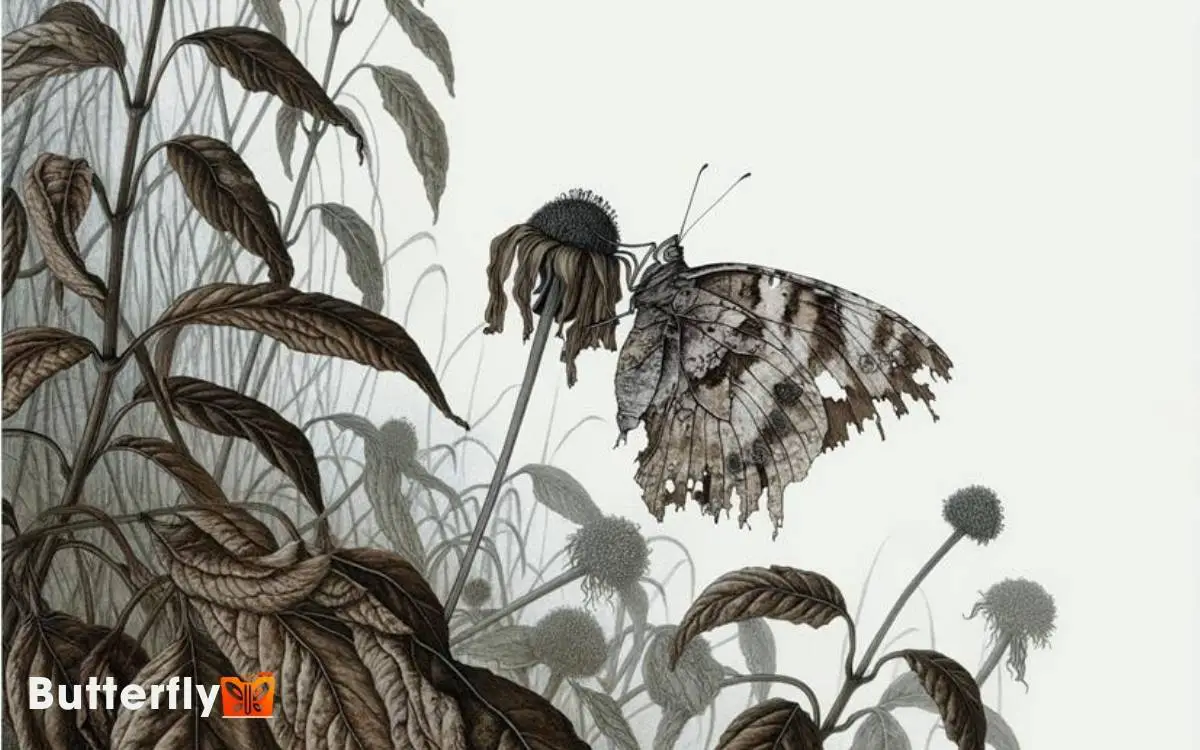How Do You Know if a Butterfly Is Dying? Identifying Signs!
To tell if a butterfly is dying, look for frayed, torn wings or faded colors. Notice any unusual behavior like reduced feeding, erratic flight, or prolonged rest. Inability to fly, lethargy, and lack of responsiveness are key indicators.
Check for physical deformities such as misshapen wings, twisted antennae, or irregular legs. Watch their feeding behavior frequent probing or not feeding at all can signal issues. Aging butterflies show dull coloration and degraded body parts.
Observing these details can reveal important insights about a butterfly’s health. If you’re curious about butterfly care, continue to discover more intricacies.

Key Takeaways
Changes in Wing Condition
One of the most apparent indicators that a butterfly is nearing the end of its life is the deterioration of its wings. You’ll notice frayed edges, tears, and missing scales. These changes occur because the wings are delicate and don’t regenerate.
As a butterfly ages, environmental factors like wind, predators, and general wear and tear take their toll. The wing veins may become more visible, and the vibrant colors fade, turning dull.
If you see a butterfly struggling to fly or resting more frequently, it’s likely because its compromised wings can’t support sustained flight.
Unusual Behavior Patterns
In addition to changes in wing condition, unusual behavior patterns can provide further insight into whether a butterfly is nearing the end of its life.
You might observe a butterfly exhibiting reduced responsiveness to stimuli or erratic movements. These changes often indicate a decline in neural function.
| Behavior Pattern | Potential Indication |
|---|---|
| Reduced Feeding Activity | Weakness or digestive issues |
| Erratic Flight Movements | Neuromuscular degeneration |
| Prolonged Rest Periods | Energy depletion |
| Lack of Escape Response | Diminished survival instincts |
| Abnormal Posturing | Muscular or skeletal problems |
Pay close attention to these behaviors. They can be critical indicators of a butterfly’s health status, helping you understand its life stage and overall well-being.
Inability to Fly
An inability to fly often signals severe physical or physiological distress in a butterfly, highlighting critical issues that may include wing damage, dehydration, or systemic illness.
Examine the wings closely for tears, deformities, or missing scales. These defects can severely impair the butterfly’s ability to generate lift.
Dehydration can be another factor; check if the butterfly appears shriveled or less vibrant. Offer a small amount of sugar water to see if it can drink.
Systemic illnesses, including viral or bacterial infections, may also manifest as flight incapacity. Symptoms like discoloration or unusual posture often accompany such conditions.
If the butterfly remains grounded despite having intact wings and adequate hydration, it’s likely suffering from a deeper, possibly incurable issue.
Weak or Lethargic Movements
You’ll notice a dying butterfly through its weak or lethargic movements. It may show limited flight capability, often struggling to take off or maintain altitude.
Additionally, it will exhibit a lack of responsiveness to stimuli and reduced feeding behavior, indicating declining health.
Limited Flight Capability
A butterfly exhibiting weak or lethargic movements often signals a decline in its health or vitality.
When you observe limited flight capability, it’s important to pay attention to whether the butterfly struggles to lift off or maintain a steady path. This can indicate muscle fatigue, dehydration, or even damage to its wings.
You might see the butterfly favoring short, erratic flights instead of its characteristic graceful, sustained glides. Take note of any visible tears or deformities in its wings, as these can drastically impair flight.
Additionally, environmental factors like extreme temperatures or a lack of nectar sources can exacerbate these issues.
Carefully evaluating these signs can help you determine the butterfly’s condition and whether it’s nearing the end of its life cycle.
Lack of Responsiveness
When you notice a butterfly exhibiting weak or lethargic movements, it often indicates a significant decline in its overall health and well-being.
A butterfly’s vitality is closely linked to its ability to move energetically. When it becomes lethargic, it could be due to factors such as aging, disease, or environmental stressors.
Observe if the butterfly struggles to open or close its wings, or if it remains stationary for prolonged periods. Healthy butterflies usually react quickly to stimuli like light or touch. A lack of such responsiveness suggests its neurological or muscular systems might be compromised.
Document these observations meticulously, as they can provide insights into the butterfly’s condition and guide any necessary interventions. Pay close attention to any changes in its behavior, wing integrity, or feeding patterns, as these factors may indicate underlying health issues. Understanding these details can also be valuable when researching how to preserve a butterfly, ensuring that its delicate structure remains intact for educational or scientific purposes. By maintaining thorough records, you can contribute to a broader understanding of butterfly care and conservation.
Reduced Feeding Behavior
Observing a butterfly’s feeding behavior is essential, as reduced feeding often signals underlying health issues. When a butterfly becomes weak or lethargic, it mightn’t have the energy to feed properly, which can be a critical indicator of its declining health.
Watch for:
- Essential feeding duration: The butterfly spends less time at flowers or feeders.
- Weak proboscis movement: The proboscis, used for feeding, moves sluggishly or not at all.
- Decreased activity: The butterfly shows less interest in flying or seeking food sources.
These observations are vital because butterflies rely on frequent feeding for energy and metabolic functions. Noticing these signs early can help you understand the butterfly’s condition and possibly intervene to provide needed care.
Physical Deformities
Physical deformities in butterflies, such as misshapen wings or twisted antennae, can indicate serious health issues and potential mortality.
You should inspect the wings closely; they should be symmetrical and free from tears. Deformities often result from pupation issues or genetic defects.
Twisted or broken antennae impair a butterfly’s ability to navigate and find food, vital for survival. Check for any irregularities in the legs or proboscis, which may hinder feeding and movement. If you notice these deformities, the butterfly’s chances of survival diminish.
It’s crucial to differentiate between injuries caused by predators and those from developmental issues, as the latter often signal deeper health problems. Observing these signs helps you understand the butterfly’s condition accurately.
Lack of Feeding
You should watch for signs of reduced appetite, as butterflies may stop feeding when they’re dying. Note any changes in their feeding behavior, such as a reluctance to visit flowers or consume nectar.
Carefully observe the proboscis; if it’s not extended or seems inactive, this could indicate serious health issues.
Appetite Reduction Signs
A key indicator that a butterfly may be nearing the end of its life is a noticeable reduction in its feeding behavior.
As butterflies age or become ill, their metabolic processes slow down, leading to decreased appetite. You should observe if the butterfly is less interested in nectar sources or other food they typically consume.
Look for these specific signs:
- Decreased visits to flowers: The butterfly spends less time hovering around or feeding from flowers.
- Prolonged rest periods: Extended periods of inactivity can indicate a lack of energy due to reduced feeding.
- Visible weight loss: A thinner, more fragile appearance can signal that the butterfly isn’t consuming enough nutrients.
These signs will help you determine if your butterfly is experiencing appetite reduction, indicating a possible decline in health.
Feeding Behavior Changes
Observing a butterfly’s feeding behavior can provide critical insights into its overall health, particularly when there is a complete lack of interest in food sources.
When a butterfly stops feeding, it indicates severe health issues. Healthy butterflies actively seek nectar, while ailing ones may ignore flowers, fruits, or sugar solutions.
| Normal Behavior | Abnormal Behavior | Possible Cause |
|---|---|---|
| Actively seeking nectar | Ignoring food sources | Illness or nearing the end of life |
| Frequent feeding | Sporadic feeding | Weakness or digestive issues |
| Probing flowers regularly | No probing activity | Potential injury or disease |
| Responding to food stimuli | Lack of response | Dehydration or malnutrition |
| Vibrant movements | Lethargy | Overall decline in health |
Monitor these changes to assess the butterfly’s condition accurately.
Observation of Proboscis
Carefully examine the butterfly’s proboscis to determine if it’s curled or extended, as abnormalities can indicate health issues. A healthy butterfly will have a proboscis that uncoils properly to feed.
If the proboscis is consistently curled, damaged, or unable to extend, it might signal that the butterfly is unable to feed properly, which can lead to starvation and death.
Observe the following signs:
- Constantly Curled Proboscis: Indicates potential injury or deformity.
- Difficulty Extending: Suggests possible muscle or neurological issues.
- Lack of Feeding: Implies the butterfly isn’t ingesting necessary nutrients.
Signs of Aging
Notice the butterfly’s wings: they may appear faded, tattered, or frayed, indicating signs of aging. As butterflies grow older, their wings lose vibrancy, becoming duller in color. Examine the edges closely; you might see small tears or missing scales.
Another sign is reduced flight capability. If the butterfly struggles to fly or remains grounded for extended periods, it’s likely experiencing age-related decline. Look at the antennae and legs too. Degradation or missing parts can signify aging.
Also, check for a diminished feeding response; older butterflies often show less interest in food. These signs collectively help you understand the butterfly’s life stage, indicating it’s nearing the end of its life cycle.
Conclusion
You’ve noticed a butterfly’s wings deteriorating, its erratic behavior, and its struggle to fly. Coincidentally, it’s also become weak and lethargic, perhaps displaying physical deformities and refusing to feed.
These signs, combined with its inevitable aging, point to its decline. Observing these precise details, you can scientifically conclude that the butterfly is nearing the end of its life cycle.
Your keen eye has captured the delicate, yet inevitable processes of nature at work.






